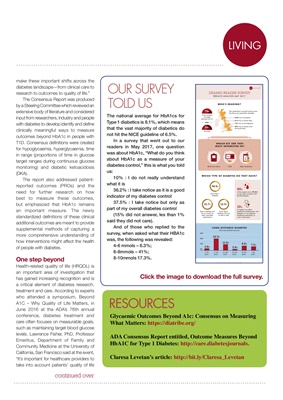
KITLIVING
research to outcomes to quality of life."
The Consensus Report was produced
by a Steering Committee which reviewed an
extensive body of literature and considered
input from researchers, industry and people
with diabetes to develop identify and define
clinically meaningful ways to measure
outcomes beyond HbA1c in people with
T1D. Consensus definitions were created
for hypoglycaemia, hyperglycaemia, time
in range (proportions of time in glucose
target ranges during continuous glucose
monitoring) and diabetic ketoacidosis
(DKA).
The report also addressed patientreported
outcomes (PROs) and the
need for further research on how
best to measure these outcomes,
but emphasized that HbA1c remains
an important measure. The newly
standardized definitions of these clinical
additional outcomes are meant to provide
supplemental methods of capturing a
more comprehensive understanding of
how interventions might affect the health
of people with diabetes.
One step beyond
Health-related quality of life (HRQOL) is
an important area of investigation that
has gained increasing recognition and is
a critical element of diabetes research,
treatment and care. According to experts
who attended a symposium, Beyond
A1C - Why Quality of Life Matters, in
June 2016 at the ADA's 76th annual
conference, diabetes treatment and
care often focuses on measurable goals,
such as maintaining target blood glucose
levels. Lawrence Fisher, PhD, Professor
Emeritus, Department of Family and
Community Medicine at the University of
California, San Francisco said at the event,
"It's important for healthcare providers to
take into account patients' quality of life
(QOL), which is more difficult to measure,
yet can greatly impact outcomes."
OUR SURVEY
TOLD US
The national average for HbA1cs for
Type 1 diabetics is 8.1%, which means
that the vast majority of diabetics do
not hit the NICE guideline of 6.5%.
In a survey that went out to our
readers in May 2017, one question
was about HbA1c, "What do you think
about HbA1c as a measure of your
diabetes control," this is what you told
us: 10% : I do not really understand
what it is
36.2% : I take notice as it is a good
indicator of my diabetes control
37.5% : I take notice but only as
part of my overall diabetes control
(15% did not answer, les than 1%
said they did not care).
And of those who replied to the
survey, when asked what their HBA1c
was, the following was revealed:
4-6 mmols - 6.3%;
6-8mmols - 41%;
8-10mmols 17.3%.
continued over
RESOURCES
Glycaemic Outcomes Beyond A1c: Consensus on Measuring
What Matters: https://diatribe.org/
ADA Consensus Report entitled, Outcome Measures Beyond
HbA1C for Type 1 Diabetes: http://care.diabetesjournals.
Claresa Levetan's article: http://bit.ly/claresa_levetan
Click the image to download the full survey.